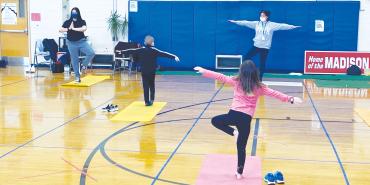When Paula Wilson read the letter, she started to cry. Her son, John Empey, had enrolled in a natural resource management course at the Seaway Career and Technical Education Center in Norwood, New York, and the letter explained that he needed the following: a helmet, work overalls, and steel-toe boots, among other gear. Wilson knew the boots alone typically cost $200, and the overalls close to $100. “There was no way I could afford it,” she said.
She called the center, and administrators there suggested she contact her son’s high school, Massena Central, where John was a junior. Soon, Wilson and her son were meeting with Kristin Colarusso-Martin, the community schools director for the Massena Central School District. Colarusso-Martin walked them to a pantry down the hall from her office where clothing, books, and food are stored. “Whatever you want, John, you can take it,” Colarusso-Martin said. She handed him a pair of boots in his size that looked almost new, and he found some name-brand hoodies that he liked. “He was just so happy to be able to get those things,” Wilson, a single mother, recalls. Colarusso-Martin also gave her two of the $50 gift cards she keeps in her office so that Wilson could purchase the helmet, work overalls, and any remaining supplies John needed for his course.
The meeting with Colarusso-Martin took place in the summer of 2019. At the time, Wilson was struggling financially. She and John had been living in public housing, out of her van, and with friends since she lost her job as a waitress; she had a heart attack in 2008 and hasn’t worked since then because she has chronic obstructive pulmonary disease. Last year, her financial situation improved when her disability claim was finally approved. In October 2020, she bought a two-bedroom house for herself and John.
This story of support for one student’s educational opportunity was made possible by a well-coordinated districtwide effort designed to help families navigate life challenges. Educators all know students like John who need resources outside the classroom so they can succeed inside the classroom. As the article on page 18 shows, community schools provide those resources by partnering with youth-serving organizations, food banks, social service agencies, health clinics, and businesses to support the academic and nonacademic needs of students and their families. The result? Teachers can focus on teaching, and students can focus on learning.
In the last 20 years, the movement to establish community schools has grown significantly. While community schools hark back to the idea of the one-room schoolhouse as the center of a rural community, many of the early community schools were established in urban settings.1 Today, rural areas like Massena, a town in St. Lawrence County in upstate New York—known as the North Country—are increasingly2 implementing the community school model to connect members of their geographically dispersed and isolated communities so that teachers, students, and families can thrive.
Finding Inspiration in Reconnecting McDowell
A once-bustling industrial town, with employers such as Reynolds Metals and General Motors long gone,3 Massena in recent years has become known for its economic woes—and for its residents banding together to confront them. When Alcoa, an aluminum manufacturing plant in Massena, announced in 2015 that it planned to close and lay off 500 workers after downsizing in previous years,4 the community leapt into action. Various labor groups, including the United Steelworkers, the AFT, and the New York State United Teachers (NYSUT), worked with community members to convince Alcoa to remain. Grassroots efforts and union mobilization culminated in a “People Over Profits” rally5 in December 2015 that Erin Covell, then president of the Massena Federation of Teachers (MFT), helped organize. Hundreds of people attended the event, and labor leaders such as AFT President Randi Weingarten spoke about the plight of workers in Massena and plans to advocate for them.
As a result of union and community pressure, the state paid Alcoa $70 million to keep the Massena plant open and preserve 600 jobs for three and a half years, thus averting the latest labor crisis.6 Knowing they needed to spend those three and a half years mobilizing and organizing, the effort to strengthen Massena’s economy and make life better for its residents officially became known as the St. Lawrence County People Project in 2016. A grassroots coalition of unions, businesses, community members, and organizations, the People Project focuses on supporting economic development, education, and health and wellness. Their efforts are paying off—for students and the economy. In March 2019, the community scored another win for its workers when Alcoa and the New York Power Authority announced a seven-year deal in which Alcoa pledged to keep its plant open after the state gave it a significant discount on electricity from the hydropower dam on the St. Lawrence River.7
The People Project was inspired by an effort the AFT launched in 2011 with community partners in McDowell County, West Virginia, another rural area, where a declining coal industry had weakened the local economy over time. Called Reconnecting McDowell, this public-private partnership has managed to connect the county to more than 100 partners who have given more than $20 million in goods and services.* Among the major investments are improvements in internet access, the digging of water lines for new home developments, and the construction of an apartment building to attract educators to McDowell’s hard-to-staff school system. Known as Renaissance Village, the apartment building was completed in August 2020 and is the first new multistory construction project in the city of Welch, McDowell’s county seat, in 50 years.8
When asked about the similarities with Reconnecting McDowell, Mary Wills, the People Project’s coordinator, says, “We’re not building buildings, but we’re doing a lot of smaller things that are really making a difference in people’s lives.” Chief among them is a focus on community schools. It’s no coincidence that establishing such schools is also a hallmark of Reconnecting McDowell; the wraparound supports core to the work of community schools can help educators, students, and families no matter where they live, be it “coal country” or the “North Country.”
So far, the community school effort in St. Lawrence County has made the biggest impact on the Massena Central School District. One of 18 districts in the sprawling county, Massena transformed all five of its schools when school district officials, with the support of the MFT, decided to use more than $200,000 set aside by the state legislature for community schools in 2016. Two other school districts in the county have hired community school coordinators and are starting to develop community partnerships. Wills is currently advising the rest of the county’s districts seeking to implement aspects of community schools—such as back-to-school events, food pantries, and partnerships with community organizations—as they try to learn from what Massena has done.
Patrick Brady, Massena’s superintendent, says the need to provide more targeted supports to the district’s 2,793 students was and remains considerable. With more than 60 percent of the student body qualifying for free or reduced-price meals,† the purpose of implementing community schools was “really to try and level the playing field,” he says.
Facing the COVID-19 Crisis as a Community
With a background in youth development and nonprofit work in the region, Kristin Colarusso-Martin was the right person to coordinate Massena’s community schools. Originally from Potsdam, about 20 miles away, she knew the challenges families faced in a rural area with limited access to jobs and opportunities, and the self-reliant culture that sometimes keeps people from seeking help. She immediately built systems to support students and developed relationships with community partners—the very heart of her work. So when the pandemic hit last spring, and schools moved to online learning, all that preparation paid off. The district’s community school infrastructure and relationships were strong enough to meet dire needs to provide food and internet access.
Randy Freiman, a chemistry teacher at Massena’s high school and the current MFT president, recalled that last spring a father was driving his daughter to the high school parking lot every afternoon so she could access the internet and complete homework in the car. “Teachers got wind of that and brought it to Kristin’s attention,” Freiman says. “She jumped right on it and said what can we do?” Colarusso-Martin worked with the Salvation Army to set up a hot spot near the family’s home. But when the location was too remote for it to work, she connected the student with tutors and free Wi-Fi at the Boys and Girls Club. As of March 2021, 20 other families were using hot spots the district was able to get installed, Freiman says.
When families needed food last spring, Colarusso-Martin directed them to food pantries and churches providing free meals. Throughout the summer, for an extended school lunch program, she worked with the district’s director of transportation and the head of food service to coordinate food deliveries to students lacking transportation. “We had volunteer drivers dropping off bags of food for a week,” she says. “It was pretty incredible.”
Since the winter, when the district implemented a hybrid model with students learning both in person and remotely, breakfast and lunch has again become available during school. To ensure no student goes without food, students can also pick up a free lunch at schools every Monday (the district’s fully remote day), and a school bus driver delivers lunches to 51 students at home. In January, the district received a $50,000 grant from No Kid Hungry, a national campaign committed to ending child hunger, to continue coordinating these efforts.
Colarusso-Martin also notes the importance of the district’s Rapid Response Team, which she helped develop two years ago. A group of 95 people—including administrators, counselors, school psychologists, food pantry directors, and law enforcement officials, among other community partners—belong to the team and meet monthly (via Zoom since the pandemic) to discuss the needs of students and families and to resolve challenges. If, for instance, a family needs housing or furniture (such as a desk for remote learning), a member of the team sends an email to the group asking for help. Typically, someone offers a solution in a matter of hours and specific support ensues. Colarusso-Martin recalls one mother who needed safe housing after leaving a domestic violence situation, but an outstanding bill of $1,000 prevented her from qualifying for a place to live. “Our faith-based community was able to patch together that thousand dollars along with some donations from people on the Rapid Response Team,” Colarusso-Martin says. The mother paid her bill, the team found her stable housing, and the district’s Supplemental Nutrition Assistance Program coordinator connected the family with benefits. The team also made sure her children had school supplies.
In previous years, Colarusso-Martin has organized a back-to-school event at the high school in which families are invited to pick up free backpacks and school supplies, learn about resources from 50 community partners, meet some of the district’s teachers, and get a free haircut from 10 hairdressers. About 2,500 people attend each year. Massena was the first district in the county to coordinate such an event in 2018, and 10 additional school districts held their own back-to-school events in 2019.
Because of the pandemic, no such event was held at the start of the 2020–21 school year. But Massena was able to continue its family home visit program this past summer. As part of the program, which began in 2019 with a $7,000 grant from NYSUT, 18 educators visited families of students entering kindergarten and junior high, two key transition points in schooling. To practice social distancing, educators met families in driveways and backyards and on porches to discuss the upcoming school year, answer questions about online learning, and listen to their hopes for their children. Colarusso-Martin says educators were trained and paid for their time, and district officials are now preparing for a third summer of family home visits.
Making Mental Health a Priority
Even before the pandemic, Massena prioritized meeting students’ mental health needs. The district employs 10 school counselors: one for each of the three elementary schools, two at the junior high school, and five at the high school. Each school also has its own school psychologist.
Wendy Serguson has worked as a counselor at Jefferson Elementary for 31 years. The move to a community school model is “the best thing that ever happened in our district,” she says. Communication between schools and outside agencies has improved, and it’s now easier for counselors to connect families with resources. Serguson says making those connections has been especially important this year, since there are more instances of depression among students who feel isolated at home.
Because the district issued Chromebooks to all students last spring when schools were fully remote, those who needed mental health supports were able to attend telehealth visits with therapists from two primary mental health organizations: the Massena Wellness Clinic and Citizen Advocates. Fortunately, Colarusso-Martin had already embedded these supports in the district’s five schools before the pandemic. After learning moved to a hybrid model, students could resume attending appointments either in school or at the clinics’ offices. Currently, the district is in talks with two local hospitals to pilot a virtual school-based health center.
Every month, Colarusso-Martin checks in with all of the counselors to see what supports students need to stay on track and to address attendance issues. In addition, a social worker is available to meet with students in the high school and junior high on in-person learning days.
One program, aptly named Handle with Care, shows just how attuned the district is to students’ mental health needs. The program, which Colarusso-Martin developed with law enforcement, outlines a specific protocol for sharing information when students are exposed to violence or trauma at home. In such cases, a law enforcement official will contact school officials, who share information with appropriate counselors and teachers so they are able to be extra sensitive to students’ needs. If a student needs counseling or other supports, Colarusso-Martin works with school staff to find the right resources.
In October 2020, the district received further support for students’ social and emotional development when the MFT won a $25,000 grant from the AFT Innovation Fund.‡ The grant has enabled the district to join in and expand a partnership with the Holistic Life Foundation, a nonprofit organization that fosters the well-being of children and adults in systemically underserved communities, that had been established by the nearby St. Regis Mohawk Tribe (whose children make up 10 percent of the district’s students). Together, these groups are incorporating mindfulness training and yoga in Massena schools and helping teachers and students heal from trauma, manage stress, build resilience, and develop coping skills.
Cathy Donahue, a French teacher at the junior high school, says the mindfulness initiative makes teachers feel cared for and supported—just as they care for and support their students. And working directly with a community school coordinator makes it far easier to translate their compassion into action. “If I have a student who I’m worried about, I don’t call the principal,” Donahue says. “I call Kristin, and I know that she is going to probably know the family and have some sort of contact or support in place so we can help those kids, 100 percent. And if she doesn’t, she’ll find them.”
For more on AFT-driven efforts to support students and families in Central New York through community schools, see “Building Community with Community Schools.”
*For more on Reconnecting McDowell, see here and “Mountains to Climb” in the Summer 2016 issue of American Educator. (return to article)
†Thankfully, all students in the district have been eligible for free meals this school year because of the US Department of Agriculture’s pandemic-driven waiver. (return to article)
‡For more on the AFT Innovation Fund, see here. (return to article)
Endnotes
1. L. Benson et al., “The Enduring Appeal of Community Schools,” American Educator 33, no. 2 (Summer 2009): 22–29, 47.
2. Coalition for Community Schools, “Community Schools Right at Home in Rural Areas,” December 2012, communityschools.org/community_schools_right_at_home_in_rural_areas; and D. Williams, The Rural Solution: How Community Schools Can Reinvigorate Rural Education (Washington, DC: Center for American Progress, 2010).
3. National Public Radio, “After Factory Plant Closures, Job Loss, A Small N.Y. Town Struggles to Bounce Back,” April 17, 2016.
4. D. Raymo, “Alcoa Massena West Plant to Close, 500 Jobs Lost,” Press-Republican, November 5, 2015.
5. L. Robinson, “Pro-Alcoa Rally Draws Hundreds,” NNY360, December 6, 2015.
6. D. Sommerstein, “Alcoa Announces 3 1/2 Year Grace Period for Massena Plant,” WRVO Public Media, November 25, 2015.
7. B. Beckstead, “Alcoa Stays: Cuomo, in Massena, Announces 7-Year Deal with NYPA to Keep Plant Open, Save 450 Jobs,” NNY360, March 22, 2019.
8. C. Bluefield, “McDowell Renaissance Village Ready for Occupants,” Register Herald, August 14, 2020.
[photos courtesy of the Massena Central School District; illustrations by Gaby D'Alessandro]




